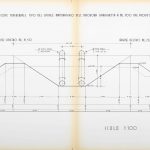Chiavichetta dewatering pump | Due Consorzi, Due Archivi – Storia del Territorio
Chiavichetta dewatering pump
NAME: Idrovora Chiavichetta (Dewatering pump Chiavichetta)
LOCATION: Porto Viro (Ro)
ORIGINAL CONSORTIUM OF BELONGING: Consortium for the Reclamation of Polesana (1890-1970)
DATE OF CONSTRUCTION: 1915-1921
DESIGNER: Eng. Carlo Marchi
HISTORICAL NOTES:
The project to complete the restoration of the artificial Consorzio Acque Dolci di Contarina on the right of the Padano Polesano Canal Mainfold was drawn up by Eng. Carlo Marchi on 22nd of March 1911 and reformed on 5th of June 1912: in it, it was planned to build two first stage systems at Ponte Chiavichetta and at Ca’ Giustinian.
Initially, the construction of the customary house for the machinist was not planned at Chiavichetta, they would have had to find accommodation in the dwellings of Ca’ Giustinian. However, with a further evaluation on 2nd of April 1915 the idea was abandoned and the construction of a small machinist house was added to the plan.
Located at the outflow of the drainage with the same name, the Chiavichetta dewatering pump was built by the Angelo Ricci company: the works began on 1st of July 1915 and on the 5th the foundations for the machinist’s house were dug. In October 1916 the masonry work was nearly complete, but the work stopped because the Tosi Company failed to deliver machinery (which had been commissioned on 29th of June 1915), due to the war. Ricci was paid from the project in June 1918, however, shortly after the arrival of the machine it was possible to carry out the complementary work, after an additional evaluation on the 24th of May 1920. At that time, a diesel engine with 75 HP and two centrifugal pumps were being installed at the dewatering pump and it was tested in 1921. Here, like at Ca’ Giustinian, the complex was built with the typical characteristic Venetian wall-water tank, built around 1922 to collect rainwater.
In the 30s, the pumps were connected to an electric high-powered motor, but it was only possibly to operate one of them with the original Tosi motor and also maintain the thermal reserve function. On that occasion the masonry part of the building underwent modifications with the addition of a workshop and an electrical cabin.
New work was carried out after the flood of 1951 and again in the 1960s, to counteract the sinking of the ground (calculated to be more than two meters), the drainage basin was blocked. They used pipelines through the embankments of Sadocca to move the water.
After a period of neglect, the renovated artefact (2008) was included in a project for the enhancement of industrial archaeology. However, it has lost its original function and the current pumps are outside the ancient building.
___________________
![]()
Project funded by Regione del Veneto – L.R. 5/09/1984 n. 50, art. 44 – DGRV n. 618 del 11 maggio 2021 e n.1411 del 12 ottobre 2021 – Decreto del Direttore della Direzione Beni Culturali e Sport n. 325 del 27.10.2021
Photos Alberto Bonatti
 Consorzio di Bonifica Delta del Po
Consorzio di Bonifica Delta del Po 








